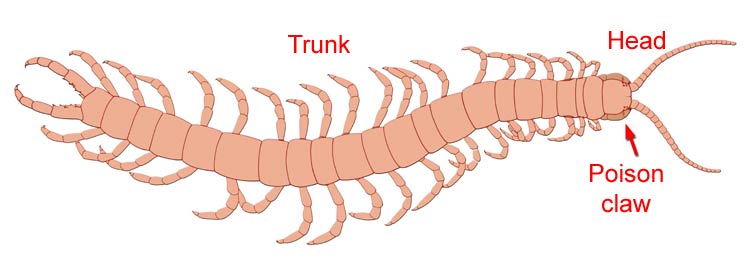
Home | Is it a mite? Home | Glossary

Common names: centipedes, hundred-leggers, logrunners
Probability of encounter: medium
Quarantine importance: Centipedes are easily transported in logs or soil and the introduction of exotic species could be of conservation concern (including the introduction of exotic mite parasites of native centipedes). The long-legged house centipede has been moved around the world by people. All known species are predators of arthropods or small vertebrates, or scavenger-detritivores. Some large tropical scolopendromorphs are poisonous and of medical concern.
Similarity to mites: None. Large scolopendromorphs are used in the pet trade and commonly have associated mites.
Morphology
Normal adult length: 3-6 cm (30 cm)
Body tagmata: head, trunk
Eyes: absent or 1- many ocelli (compound eyes in Scutigeromorpha)
Antennae: elongate (hind legs often antenna-like)
Mouthparts: ectognathous mandibles, 1st maxillae with fused coxae, 2nd
maxillae with limb-like processes, labrum, poison claws (maxillipeds)
Legs: 15-191 pairs of legs in adults
Respiration: paired spiracles on trunk segments in pleural region, but
those of scutigeromorphs open in dorsal tergite
Gonopore: on legless terminal segment
Distinguishing features: poison claws; one pair of legs per trunk segment;
usually last pair of limbs elongate, antenna-like; organ of Tomosvary at base
of each antenna (Lithobiomorpha, Scutigeromorpha)
Comments: The poison claws
or maxillipeds are distinctive. Unlike pauropods and millipedes, centipedes
have a second pair of maxillae. The mandibles may have many pectinate lamellae
as in Parajapyx (Diplura). Tarsi end in a single claw, rarely 2-3 claws.
Diversity: 5
orders, >17 families, >2800 spp. (poorly resolved taxonomically)
Geophilomorpha have 31-181 pairs of legs in all stages and usually 14-segmented antennae (but lack Tomosvary organs and eyes).
These worm-like centipedes are the only ones to live up to the class' common
name (hundred-leggers).
Scolopendromorpha have 21 or 23 pairs of legs in all stages and include some very large and venomous species.
Scutigeromorpha have 4 pairs of legs on hatching and 15 pairs of legs as adults. These are the only centipedes with a type of compound eyed includes the common house centipede of basement and bathtub fame.
Lithobiomorpha have 15 pairs of legs in adults, but usually 7 pairs on hatching. Segments and legs are added during development. Lithobiomorphs also have 18 to >100 segments in their antennae, an organ of Tomosvary near the base of each antenna, 0-30 pairs of ocelli, and can produce silk from the hind legs.
Craterostigmomorpha are restricted to Australasia and have 12 pairs of legs on hatching and 15 pairs of legs as adults. Poison claws project in front of the head.
References
Tree of Life - http://tolweb.org/tree?group=Chilopoda&contgroup=Arthropoda
Edgecombe, G. 2001. Centipedes: The great Australian bite. Nature Australia Autumn 2001: 42-51
Lewis, JG. 1981. The Biology of Centipedes. Cambridge University press: Cambridge.
Mesibov, R. 1986. A guide to Tasmanian centipedes. Mesibov: Tasmania.
Mesibov, R. 1995.
Distribution and ecology of the centipede Craterostigmus tasmanianus
Pocock, 1902 (Chilopoda: Craterostigmomorpha: Craterostigmidae) in Tasmania.
Tasmanian Naturalist 117: 2-7.
Mundel, P. 1990. Chilopoda. pp. 819-833, in DL Dindal (ed) Soil Biology Guide.
John Wiley & Sons: Brisbane.